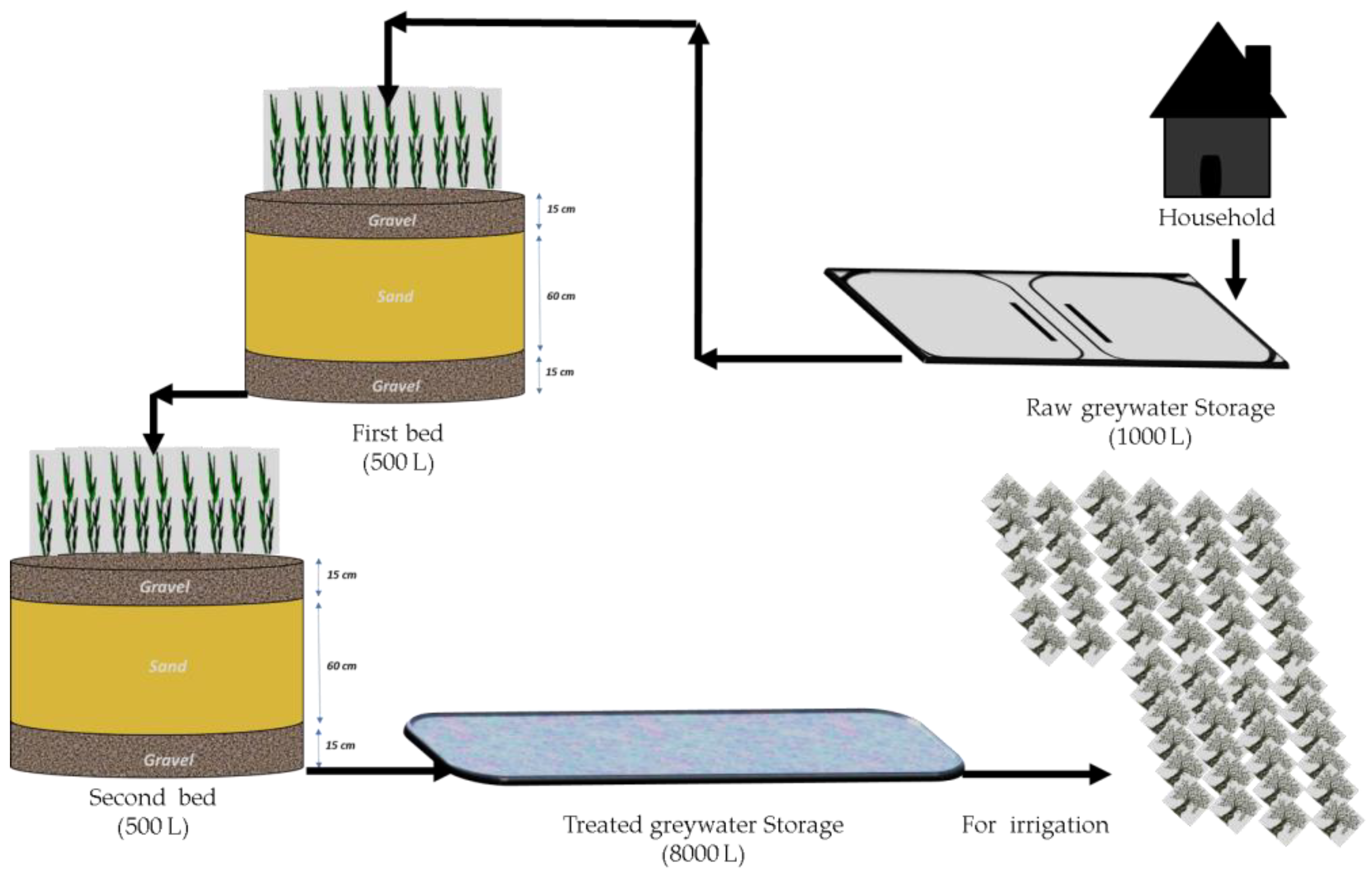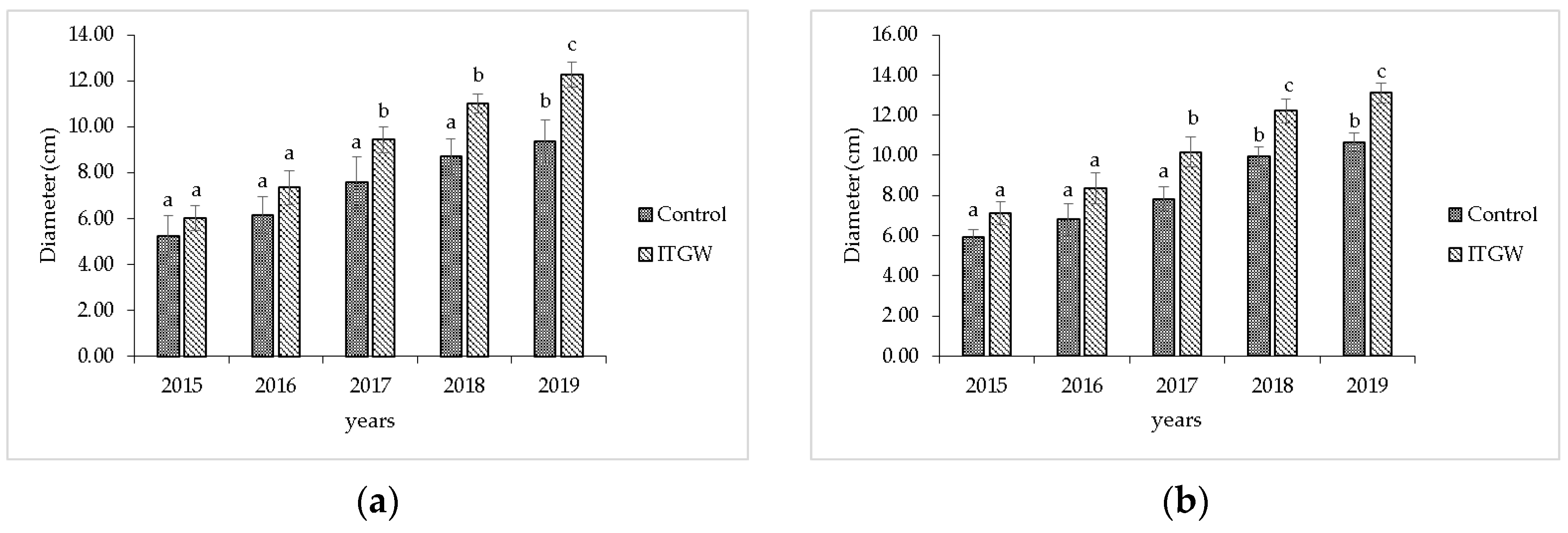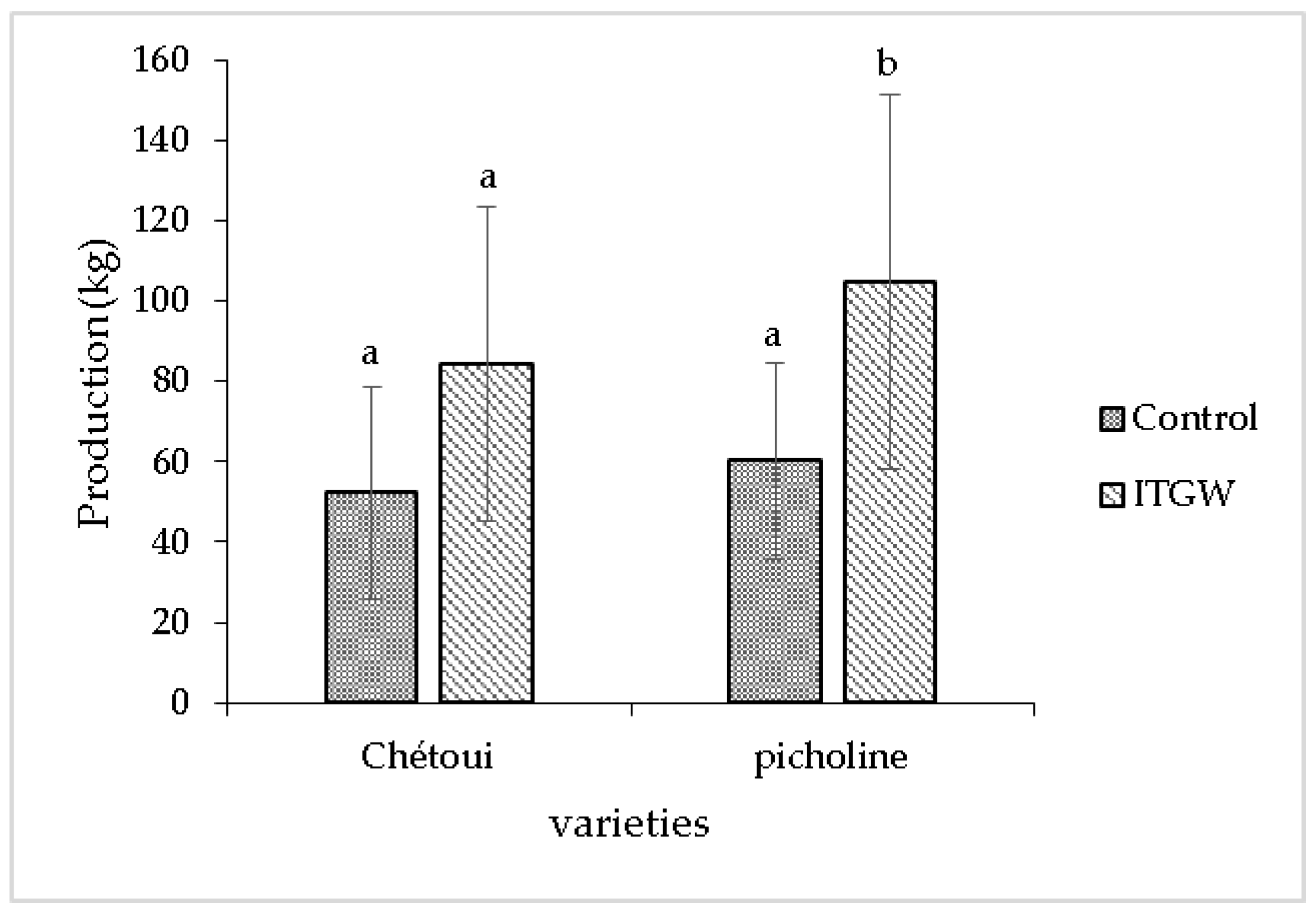Greywater Vertical Treatment and Possibility of Reuse in the Fields from Peri-Urban Area
Abstract
1. Introduction
2. Materials and Methods
2.1. Experiment Site and Plant Material
2.2. Greywater Origin and Treatment Unit
2.3. Sampling and Analysis
2.3.1. Greywaters
2.3.2. Olive Trees
2.4. Statistical Analysis
3. Results and Discussion
3.1. Greywater Treatment
3.2. Valorization of Treated Greywater
3.2.1. Growth Parameters of Olive Trees: Diameter (D) and Height (H) of Trees
3.2.2. Olive Trees Production
4. Conclusions
Author Contributions
Funding
Data Availability Statement
Acknowledgments
Conflicts of Interest
References
- UNESCO. La Mise en Valeur de Ressources en eau. 2021. Available online: https://www.unesco.org/reports/wwdr/2021/fr (accessed on 13 March 2023).
- Jiang, L.; Bao, A.; Yuan, Y.; Zheng, G.; Guo, H.; Yu, T.; De Maeyer, P. The effects of water stress on croplands in the Aral Sea basin. J. Clean. Prod. 2020, 254, 120114. [Google Scholar] [CrossRef]
- Ministère de l’agriculture de Tunisie. Rapport National du Secteur de l’eau. 2020. Available online: http://www.onagri.tn/uploads/Etudes/livre-FINAL-Rapport-national.pdf (accessed on 13 March 2023).
- Parliament, E.E.; Council of the European Union. On minimum requirements for water reuse. Off. J. Eur. Union 2020, 32–55. Available online: http://www.onagri.nat.tn/uploads/Etudes/Revue_2020_final.pdf (accessed on 13 March 2023).
- Barsan, N.; Nedeff, V.; Temea, A.; Mosnegutu, E.; Chitimus, A.D.; Tomozei, C. A Perspective for Poor Wastewater Infrastructure Regions: A Small-scale Sequencing Batch Reactor Treatment System. Chem. J. Mold. 2017, 12, 61–66. [Google Scholar] [CrossRef]
- Filali, H.; Barsan, N.; Souguir, D.; Nedeff, V.; Tomozei, C.; Hachicha, M. Greywater as an Alternative Solution for a Sustainable Management of Water Resources—A Review. Sustainability 2022, 14, 665. [Google Scholar] [CrossRef]
- Ministère de l’Agriculture des Ressources Hydrauliques et de la Pêche-Agence Française de Développement. Elaboration du Plan Directeur National de Réutilisation des Eaux Usées Traitées en Tunisie—Water Reuse 2050. 2022. Available online: https://onagri.home.blog/2022/07/04/elaboration-du-plan-directeur-national-de-reutilisation-des-eauxusees-traitees-en-tunisie-water-reuse-2050/ (accessed on 13 March 2023).
- Regelsberger, M.; Baban, A.; Bouselmi, L.; Shafy, H.A.; El Hamouri, B. Zer0-M, sustainable concepts towards a zero outflow municipality. Desalination 2007, 215, 64–72. [Google Scholar] [CrossRef]
- Faruqui, N.; Al-Jayyousi, O. Greywater Reuse in Urban Agriculture for Poverty Alleviation. Water Int. 2002, 27, 387–394. [Google Scholar] [CrossRef]
- Reda, A. Spatial Relationship between Irrigation Water Salinity, Waterlogging, and Cropland Degradation in the Arid and Semi-Arid Environments. Remote Sens. 2021, 13, 1047. [Google Scholar] [CrossRef]
- Alsulaili, A.D.; Hamoda, M.F.; Al-Jarallah, R.; Alrukaibi, D. Treatment and potential reuse of greywater from schools: A pilot study. Water Sci. Technol. 2017, 75, 2119–2129. [Google Scholar] [CrossRef] [PubMed]
- Singh, S.; Ahammed, M.M.; Shaikh, I.N. Combined coagulation and intermittent sand filtration for on-site treatment of greywater. IOP Conf. Ser. Mater. Sci. Eng. 2021, 1114, 012031. [Google Scholar] [CrossRef]
- Lin, C.-J.; Lo, S.-L.; Kuo, C.-Y.; Wu, C.-H. Pilot-Scale Electrocoagulation with Bipolar Aluminum Electrodes for On-Site Domestic Greywater Reuse. J. Environ. Eng. 2005, 131, 491–495. [Google Scholar] [CrossRef]
- Masoud, A.M.N.; Alfarra, A.; Sorlini, S. Constructed Wetlands as a Solution for Sustainable Sanitation: A Comprehensive Review on Integrating Climate Change Resilience and Circular Economy. Water 2022, 14, 3232. [Google Scholar] [CrossRef]
- Nielsen, S.; Stefanakis, A.I. Sustainable Dewatering of Industrial Sludges in Sludge Treatment Reed Beds: Experiences from Pilot and Full-Scale Studies under Different Climates. Appl. Sci. 2020, 10, 7446. [Google Scholar] [CrossRef]
- Collivignarelli, M.C.; Carnevale Miino, M.; Gomez, F.H.; Torretta, V.; Rada, E.C.; Sorlini, S. Horizontal Flow Constructed Wetland for Greywater Treatment and Reuse: An Experimental Case. Int. J. Environ. Res. Public Health 2020, 17, 2317. [Google Scholar] [CrossRef] [PubMed]
- Gross, A.; Shmueli, O.; Ronen, Z.; Raveh, E. Recycled vertical flow constructed wetland (RVFCW)—A novel method of recycling greywater for irrigation in small communities and households. Chemosphere 2007, 66, 916–923. [Google Scholar] [CrossRef] [PubMed]
- do Couto, E.d.A.; Calijuri, M.L.; Assemany, P.P.; Santiago, A.d.F.; Carvalho, I.d.C. Greywater production in airports: Qualitative and quantitative assessment. Resour. Conserv. Recycl. 2013, 77, 44–51. [Google Scholar] [CrossRef]
- Byrne, J.; Dallas, S.; Anda, M.; Ho, G. Quantifying the Benefits of Residential Greywater Reuse. Water 2020, 12, 2310. [Google Scholar] [CrossRef]
- Yusof, M.F.; Zainol, M.R.R.M.A.; Riahi, A.; Zakaria, N.A.; Shaharuddin, S.; Juiani, S.F.; Noor, N.M.; Zawawi, M.H.; Ikhsan, J. Investigation on the Urban Grey Water Treatment Using a Cost-Effective Solar Distillation Still. Sustainability 2022, 14, 9452. [Google Scholar] [CrossRef]
- Busgang, A.; Friedler, E.; Gilboa, Y.; Gross, A. Quantitative Microbial Risk Analysis for Various Bacterial Exposure Scenarios Involving Greywater Reuse for Irrigation. Water 2018, 10, 413. [Google Scholar] [CrossRef]
- Travis, M.J.; Wiel-Shafran, A.; Weisbrod, N.; Adar, E.; Gross, A. Greywater reuse for irrigation: Effect on soil properties. Sci. Total Environ. 2010, 408, 2501–2508. [Google Scholar] [CrossRef]
- Collivignarelli, M.C.; Carnevale Miino, M.; Baldi, M.; Manzi, S.; Abbà, A.; Bertanza, G. Removal of non-ionic and anionic surfactants from real laundry wastewater by means of a full-scale treatment system. Process Saf. Environ. Prot. 2019, 132, 105–115. [Google Scholar] [CrossRef]
- CERTE. Nature Based Solutions for Domestic Water Reuse in Mediterranean Countries NAWAMED. 2022. Available online: https://www.enicbcmed.eu/sites/default/files/2019-11/poster.pdf (accessed on 13 March 2023).
- Shoushtarian, F.; Negahban-Azar, M. Worldwide Regulations and Guidelines for Agricultural Water Reuse: A Critical Review. Water 2020, 12, 971. [Google Scholar] [CrossRef]
- Khaboua, W.; Amara, F.B.; Rekik, H.; Beghir, M.; Touir, A. Performance evaluation in olive trees irrigated by treated wastewater. Desalination 2009, 246, 329–336. [Google Scholar] [CrossRef]
- Chiraz, M.-C. Caracterisation d’un e Collection Varietale D’oliviers (Olea europaea L.). 2017, p. 95. Available online: http://www.iosfax.agrinet.tn/annonce/documentcollectionvarietale.pdf (accessed on 13 March 2023).
- Potivichayanon, S.; Sittitoon, N.; Vinnerås, B. Exposure assessment of treated greywater reused for irrigation. Water Supply 2021, 21, 4404–4417. [Google Scholar] [CrossRef]
- Leonard, M.; Gilpin, B.; Robson, B.; Wall, K. Field study of the composition of greywater and comparison of microbiological indicators of water quality in on-site systems. Environ. Monit. Assess. 2016, 188, 475. [Google Scholar] [CrossRef] [PubMed]
- Chaabane, S.; Bahrini, R.; Riahi, K.; Thayer, B.B. Contribution de matériaux filtrants: Déchets de marbre et sable à la rétention des phosphates des eaux grises. Int. J. Sci. Res. Eng. Technol. 2015, 3, 2356–5608. [Google Scholar]
- Mohamed, R.M.; Kassim, A.H.; Anda, M.; Dallas, S. A monitoring of environmental effects from household greywater reuse for garden irrigation. Environ. Monit. Assess. 2013, 185, 8473–8488. [Google Scholar] [CrossRef] [PubMed]
- Kananke, T.; Wansapala, J.; Gunaratne, A. Heavy Metal Contamination in Green Leafy Vegetables Collected from Selected Market Sites of Piliyandala Area, Colombo District, Sri Lanka. Am. J. Food Sci. Technol. 2014, 2, 139–144. [Google Scholar] [CrossRef]
- Noutsopoulos, C.; Andreadakis, A.; Kouris, N.; Charchousi, D.; Mendrinou, P.; Galani, A.; Mantziaras, I.; Koumaki, E. Greywater characterization and loadings—Physicochemical treatment to promote onsite reuse. J. Environ. Manag. 2018, 216, 337–346. [Google Scholar] [CrossRef]
- Manios, T.; Stentiford, E.I.; Millner, P. The removal of chemical oxygen demand from primary-treated domestic wastewater in subsurface-flow reed beds using different substrates. Water Environ. Res. 2003, 75, 336–341. [Google Scholar] [CrossRef]
- Shaikh, I.N.; Ahammed, M.M. Effect of operating mode on the performance of sand filters treating greywater. Environ. Sci. Pollut. Res. Int. 2021, 28, 38209–38223. [Google Scholar] [CrossRef]
- Duke, W.F.; Nordin, R.; Mazumder, A. Comparative Analysis of the Filtron and Biosand Water Filters. 2006. Available online: http://potterswithoutborders.com/wp-content/uploads/2011/06/comparative_analysis_of_the_fltron_and_biosand_water_filterseditms.pdf (accessed on 13 March 2023).
- Young-Rojanschi, C.; Madramootoo, C. Intermittent versus continuous operation of biosand filters. Water Res. 2014, 49, 1–10. [Google Scholar] [CrossRef] [PubMed]
- Verma, S.; Daverey, A.; Sharma, A. Slow sand filtration for water and wastewater treatment—A review. Environ. Technol. Rev. 2017, 6, 47–58. [Google Scholar] [CrossRef]
- Oloruntade, A.J.; Alao, F.; Alatise, M.O.; Olanrewaju, O.O. Effects of Treated Greywater on Some Growth Parameters of Pepper (Capsicum annum) in Akure, Nigeria. 2022. Available online: https://papers.ssrn.com/sol3/papers.cfm?abstract_id=4005269 (accessed on 13 March 2023).
- Nwaokobia, K.; Ogboru, R.O.; Idibie, C.A. Effects of grey water irrigation on the cultivation of African spinach (Amaranthus hybridus). Wolrd News Nat. Sci. 2018, 18, 133–145. [Google Scholar]
- Mzini, L.L.; Winter, K. Analysis of grey-water used for irrigating vegetables and possible effects on soils in the vicinity of Umtata Dam, Eastern Cape. Water SA 2015, 41, 115. [Google Scholar] [CrossRef]
- Othman, A.S.A. The Use of Treated Gray Water forIrrigation of Rainfed Olives. 2004. Available online: https://repository.najah.edu/items/f3aa1d72-2325-464d-9b67-c9cf6ceb0203 (accessed on 13 March 2023).





| Parameter | Unit of Measurement | 2014 | 2015 | 2016 | 2017 | 2019 | PW | NT106.03 | WHO | |||||
|---|---|---|---|---|---|---|---|---|---|---|---|---|---|---|
| UGW | TGW | UGW | TGW | UGW | TGW | UGW | TGW | UGW | TGW | - | - | - | ||
| Physicochemical parameters | ||||||||||||||
| pH | - | 7.54 | 7.47 | 7.87 | 8.09 | 7.33 | 7.86 | 7.96 | 8.28 | 7.39 | 7.66 | 7.69 | 6.5–8.5 | 6.5–8 |
| EC | dS/m | 2.25 | 2.52 | 1.65 | 2.14 | 2.33 | 2.46 | 2.37 | 2.43 | 2.56 | 2.77 | 0.56 | 7 | 0.7–3 |
| Cl− | me/L | 6.07 | 15.80 | 10.27 | 21.14 | 6.07 | 1.99 | 9.95 | 12.18 | 10.99 | 12.38 | 5.93 | 700 | 140–350 |
| HCO3− | me/L | 8.86 | 13.09 | 11.57 | 11.98 | 7.98 | 8.69 | 7.71 | 5.69 | 9.87 | 10.35 | 3.32 | ND | ND |
| SO42− | me/L | 7.74 | 6.58 | 4.83 | 6.10 | 7.74 | 4.78 | 7.09 | 6.32 | 7.74 | 9.42 | 3.07 | ND | ND |
| Ca2+ | me/L | 1.22 | 4.32 | 5.24 | 6.25 | 11.22 | 4.98 | 4.79 | 4.37 | 7.07 | 6.95 | 2.16 | ND | ND |
| Mg2+ | me/L | 9.21 | 1.30 | 1.76 | 2.19 | 9.21 | 1.40 | 3.49 | 3.11 | 1.24 | 0.66 | 2.19 | 50 | ND |
| K+ | me/L | 12.78 | 1.70 | 2.10 | 2.10 | 12.78 | 1.28 | 0.74 | 1.00 | 0.80 | 1.41 | 0.22 | 50 | ND |
| Na+ | me/L | 9.48 | 32.80 | 16.43 | 18.07 | 9.48 | 19.15 | 15.72 | 1.22 | 26.87 | 19.96 | 2.18 | 300 | 96–207 |
| SAR | ratio | 16.07 | 19.83 | 9.14 | 9.40 | 17.19 | 12.23 | 8.00 | 9.99 | 13.08 | 10.94 | 1.48 | ND | <13 |
| Cd | mg/L | 0.01 | 0.01 | 0.01 | 0.01 | 0.01 | 0.01 | 0.01 | 0.01 | 0.01 | 0.00 | - | 0.01 | <0.01 |
| Cu | mg/L | 0.02 | 0.01 | 0.01 | 0.00 | 0.31 | 0.04 | 0.09 | 0.01 | 0.14 | 0.00 | - | 0.5 | ND |
| Co | mg/L | 0.02 | 0.05 | 0.02 | 0.03 | 0.02 | 0.02 | 0.02 | 0.03 | - | - | - | 0.1 | ND |
| Cr | mg/L | 0.03 | 0.03 | 0.03 | 0.03 | 0.04 | 0.03 | 0.02 | 0.05 | - | - | - | 0.1 | ND |
| Fe | mg/L | 0.16 | 1.40 | 0.40 | 0.30 | 0.25 | 0.28 | 0.28 | 0.34 | - | - | - | 5 | 0.1–1.5 |
| Mn | mg/L | 0.14 | 0.07 | 0.16 | 0.06 | 0.05 | 0.08 | 0.06 | 0.14 | - | - | - | 0.5 | ND |
| Ni | mg/L | 0.04 | 0.07 | 0.04 | 0.04 | 0.04 | 0.04 | 0.03 | 0.07 | - | - | - | 0.2 | ND |
| Pb | mg/L | 0.03 | 0.04 | 0.04 | 0.04 | 0.03 | 0.04 | 0.04 | 0.07 | - | - | - | 1 | <5 |
| Zn | mg/L | 0.04 | 0.07 | 0.05 | 0.06 | 0.05 | 0.06 | 0.04 | 0.26 | - | - | - | 5 | <2 |
| Biological parameters | ||||||||||||||
| BOD5 | mgO2/L | 116.16 | 14.01 | 112.73 | 11.4 | 172.95 | 17.00 | 203.00 | 17.59 | 197.36 | 16.58 | 0.58 | 30 | ND |
| COD | mgO2/L | 239.96 | 39.37 | 213.65 | 33.08 | 246.19 | 56.50 | 236.62 | 56.07 | 514.36 | 62.90 | 6.07 | 90 | ND |
| Microbiological parameters | ||||||||||||||
| TC | log10/100 mL | - | - | 3.15 | 3.04 | 2.81 | 0.54 | 2.80 | 1.59 | 3.62 | 0.52 | - | ND | ND |
| FC | log10/100 mL | - | - | 0.66 | 1.36 | 0.79 | 0.57 | 0.73 | 0.37 | 0.79 | 1.35 | - | ND | ND |
| SF | log10/100 mL | - | - | 1.04 | 1.54 | 0.64 | 0.53 | 0.60 | 0.35 | 0.56 | 1.05 | - | ND | ND |
| E. coli | log10/100 mL | - | - | 1.08 | 1.08 | 0.75 | 0.58 | 0.71 | 0.58 | 0.68 | 0.78 | - | ND | 104–105 |
| TC | FC | E. coli | FS | |
|---|---|---|---|---|
| UGW | ||||
| log10 unit | ||||
| Average | 3.09 ± 0.87 a * | 3.07 ± 0.74 a | 3.33 ± 0.81 a | 2.89 ± 0.71 a |
| TGW | ||||
| log10 unit | ||||
| Average | 1.42 ± 0.63 b | 2.44 ± 0.91 ab | 2.73 ± 0.75 ab | 2.53 ± 0.87 a |
| Year | 2016 | 2017 | 2018 | 2019 |
|---|---|---|---|---|
| Chétoui | ||||
| N olive trees | 15 | 15 | 15 | 15 |
| Control | 13.92 | 59.71 | 64.51 | 73.11 |
| ITGW | 26.77 | 93.24 | 104.5 | 112.41 |
| Olive Production (kg) | 40.69 | 152.95 | 169.01 | 185.52 |
| Picholine | ||||
| N olive trees | 18 | 18 | 18 | 18 |
| Control | 25 | 63.62 | 72.45 | 79.69 |
| ITGW | 39.12 | 108.07 | 126.30 | 146.15 |
| Olive production (kg) | 64.12 | 171.69 | 198.75 | 225.84 |
| Annual olive production (kg) | 104.81 | 324.64 | 367.76 | 411.36 |
| Chétoui | Picholine | |||
| Control | ITGW | Control | ITGW | |
| N olives trees | 15 | 15 | 18 | 18 |
| Average | 52.2 ± 26.51 a | 84.23 ± 39.10 b | 60.19 ± 24.36 a | 104.91 ± 46.53 b |
| CV% | 50.79 | 46.42 | 40.47 | 44.35 |
Disclaimer/Publisher’s Note: The statements, opinions and data contained in all publications are solely those of the individual author(s) and contributor(s) and not of MDPI and/or the editor(s). MDPI and/or the editor(s) disclaim responsibility for any injury to people or property resulting from any ideas, methods, instructions or products referred to in the content. |
© 2023 by the authors. Licensee MDPI, Basel, Switzerland. This article is an open access article distributed under the terms and conditions of the Creative Commons Attribution (CC BY) license (https://creativecommons.org/licenses/by/4.0/).
Share and Cite
Filali, H.; Barsan, N.; Hörmann, G.; Nedeff, V.; Irimia, O.; Nedeff, F.; Hachicha, M. Greywater Vertical Treatment and Possibility of Reuse in the Fields from Peri-Urban Area. Agronomy 2023, 13, 940. https://doi.org/10.3390/agronomy13030940
Filali H, Barsan N, Hörmann G, Nedeff V, Irimia O, Nedeff F, Hachicha M. Greywater Vertical Treatment and Possibility of Reuse in the Fields from Peri-Urban Area. Agronomy. 2023; 13(3):940. https://doi.org/10.3390/agronomy13030940
Chicago/Turabian StyleFilali, Hanen, Narcis Barsan, Georg Hörmann, Valentin Nedeff, Oana Irimia, Florin Nedeff, and Mohamed Hachicha. 2023. "Greywater Vertical Treatment and Possibility of Reuse in the Fields from Peri-Urban Area" Agronomy 13, no. 3: 940. https://doi.org/10.3390/agronomy13030940
APA StyleFilali, H., Barsan, N., Hörmann, G., Nedeff, V., Irimia, O., Nedeff, F., & Hachicha, M. (2023). Greywater Vertical Treatment and Possibility of Reuse in the Fields from Peri-Urban Area. Agronomy, 13(3), 940. https://doi.org/10.3390/agronomy13030940









